Well, a quick live report from Bandon, Oregon… I’m down here as an instructor with Best of the Northwest Photo Workshops. We’ll be visiting a number of locations along the southern Oregon coast, but are basing ourselves in Bandon, Oregon… which is home to some of the more dramatic landscapes along the entire Oregon coastline. I’ll add to this post as the weekend progresses, and I have more photos to post.
I might create different galleries for the various shooting locations we’re visiting in this area. We’ll see how this works (it’s kind of an experiment at this point, and actually… I’m not sure much of anyone will be reading this anyway :-).
Last night, we headed out to the beach right across the street for some night photography. The idea was to “paint” the seastacks, with stars behind them. The stars were out in force, with the Milky Way adding a curtain of white down to the horizon – very nice. As it turns out, there was enough ambient light from the nearby hotel & other buildings to light the rocks just about the right amount anyway.
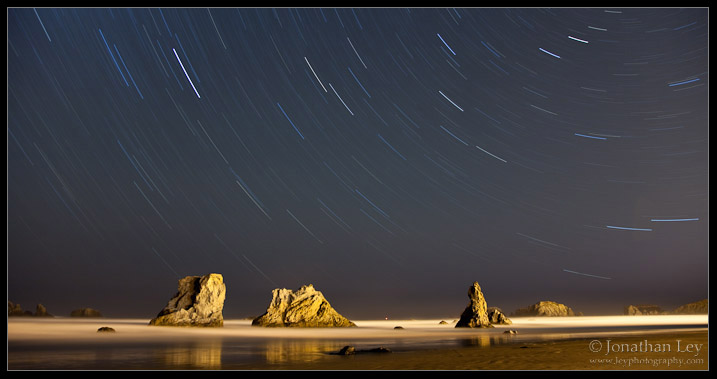
This shot was a 30 minute exposure, looking over the sea stacks. It’s an interesting thing, doing a 30 minute exposure. I mean, it’s a real commitment. I had to stand out there in the dark and cold, while nothing happened… for 30 minutes. Oh poor little old me. I guess it was kind of serene in a way, I thought about all of the billions and billions of stars, and the alien who was likely looking back at me from some distant galaxy. I stretched my aching musles. And… well, that’s about it. I just plain waited, I guess. I couldn’t really run inside while the photo was being taken, as I didn’t want my camera to wind up in the ocean. In case anyone is curious, this image was 30 mintues long, at f4, and ISO 100. I calculted this by taking a 30 second exposure at ISO 6400 that turned out OK. So, ISO 3200 would have been 1 minute, ISO 1600 = 2 minutes, ISO 800 = 4 minutes, ISO 400 = 8 minutes, ISO 200 = 16 minutes, ISO 100 = 32 minutes (and I rounded to 30 minutes). And I did this in my head – impressed? (OK, I didn’t think so).
When the image was finally “taken”, I had to wait another 30 minutes for the camera to take a “dark frame” to do noise reduction. But, I was able to do that back in the parking lot, and go warm up in the hotel room. Though, I did leave the camera outside in the cold while it processed… it’s a good idea to keep the temperature of the sensor constant while doing dark-frame noise reduction, as the noise pattern is influenced by the temperature. Basically, the camera takes another image of the same length, but with the shutter closed. So, it’s a picture of the noise pattern on the sensor (very clever, those camera engineers). Then, the camera subtracts-out the noise, and you get a pretty darn clean image.
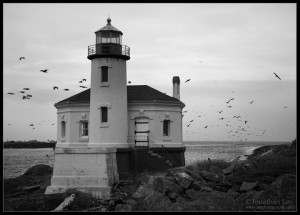
The next day has been a lot more scouting and getting used to shooting around here. In the morning, we checked out the Coquille River Lighthouse. The most interesting thing about it was the huge population of Brown Pelicans that came past the area in wave after wave. Thousands of these birds are congregating around this area right now. I’m not sure why, but it likely has to do with the weather or food… or some seasonal pattern. There’s not much else in the pelican’s life to deal with. Anyway, it was a bit of a challenge to get any decent shots of them, as it was pretty dark when we were down there, and they were slowly migrating to the other side of the river – quite some distance away.
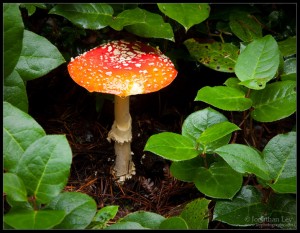
Later, we headed down to a forested area, and were treated with a similar abundance… of mushrooms. Many types were poking out through the forest duff. Though, the recent rain had them all a bit slimy. The slime factor was both good and bad. The water can make the colors of the mushrooms richer, but it also turns them into, well… mush. The most striking of the mushrooms were these Amanita. These might be beautiful, but they’re not something you want to eat, unless you want to hallucinate, get sick, and maybe even die. The color of this mushroom is especially nice to photograph in contrast to the green plants and otherwise drab forest undergrowth.
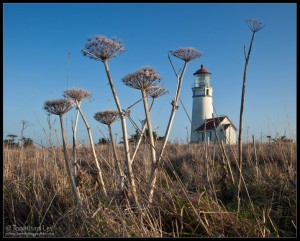
Next morning… we just got back from more shooting in the Bandon, Oregon area. The weather has improved… perhaps too much. Ideally, we’re looking for nice clouds above with clear horizons to the side. This allows the sun to light up the clouds in the morning or evening. Anyway, it’s much better to have a clear sunrise with few clouds than a cloudy or rainy sunrise that completely hides the sun (which makes the moment of surise kind of meaningless). Well, I was able to get this shot of the Cape Blanco lighthouse just as the sun crested over the ridge, and gave nice side-light to the dead grasses below the lighthouse. The only way to get enough contrast in the image to actually see these funky plants was to get down low and have the plain sky behind them. Luckily, there was just enough space for the lighthouse to provide a little context and interest to the image. There are zillions of lighthouse pictures out there, and plenty of this lighthouse in particular. So, I’m always looking for some different angles. Another great thing to look for are various details around the lighthouse. There are usually things that are endemic to lighthouses, and help make interesting images (like ropes, buoys, peeling paint, fences, etc.) I didn’t have time to do much of that, but some people in our group were able to get some nice shots of things like that.
In the evening, we headed to a section of coast just north of Cape Blanco. This involved hiking a couple miles through the same mushroom-infested forest we visited the other day. It was interesting to see how only a couple days had changed some familiar mushrooms, and seen the birth of new ones. The sun and clouds didn’t really cooperate too much, so we were left with a bit of gray drabness. So, we had to focus on small subjects, and more on the form and shape of things. Luckily, we did have the mushrooms to keep us busy. The sun did poke out through a hole in the clouds for just a few seconds as we were heading out, but most of us were in the forest, making it pretty hard to take advantage of the amber rays.
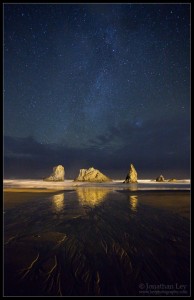
After dinner, the group headed back down to Bandon Beach for some night shooting. Conditions were pretty similar to the first night we did this. I had spotted an area that I wanted to photograph, and headed back there to see what I could come up with. With this shot, I set up my tripod in a small stream that was flowing down the beach. The lights from the hotel were lighting up the rocks again, and giving just a small bit of highlight to the ripples in the stream. The ripples work as leading lines into the frame, and just add another point of interest. Revisiting locations and shooting conditions like this really give a good way to think about a shot and plan something special. It doesn’t always work, but when it does…
The next morning we just walked across the street to Bandon Beach for sunrise. The sun did indeed rise… behind a thick wall of clouds. Well, a little color did appear through the blanket, but not much, and not for long. Still, it was a good opportunity to try some “sloshy water” shots. The idea with these is to use a shutter speed of about a second while some turbulent water sloshes up, over and around rocks in the foreground. The result is usually pretty random… but every now and then, an interesting image happens. One of the hardest parts of doing this kind of shot is finding a spot to do it in. It really helps if the water is sloshing in the immediate forground. The trouble is that you can’t hold back the ocean, and the immediate forground is near your feet. Plus, sloshy water tends to also be deep. So, one of the best solutions is to find some rocks in the inter-tidal zone that are a few feet high, and hang out there. Still, you’re playing with fire (well, water), so expect some wet feet!

Evening at Bandon Beach was spectacular. It was one of the better sunsets I’ve seen, and to be in such an interesting place with a camera and a group of dedicated photographers was wonderful. The only problem was that there was so much to shoot, it was hard to narrow things down. Tidepools, pelicans, flaming red skies, crashing waves, and contorted rocks… these were all in abundance. Anyway, I just had to make some decisions. I did take a few shots of the Sea Anemones and Starfish, a few of the crashing waves… A few of us had a moment with a wayward pelican that was alone on the beach. I got some nice photos of him standing there, but when he took off I missed the focus on what would have been the best shot. Dang. Oh well, I did manage to get a nice silohuette of penguins on a rock far offshore. The “great ball of fire” is a great compositional element if you have something compelling to put in front of it. Even after the sun set, we continued shooting the forms of sea stacks and the glowing reds and purples reflected in the wet sand.